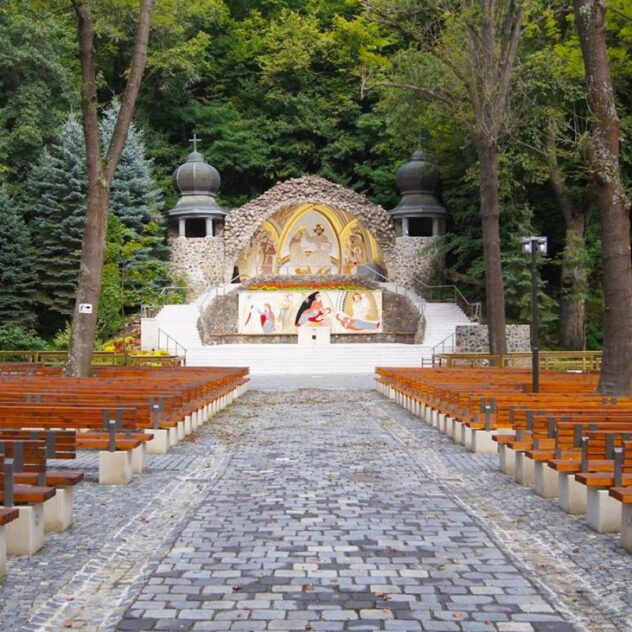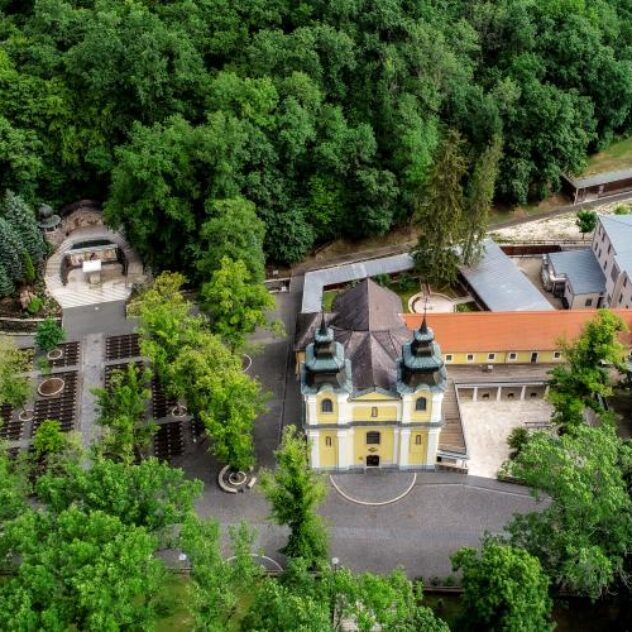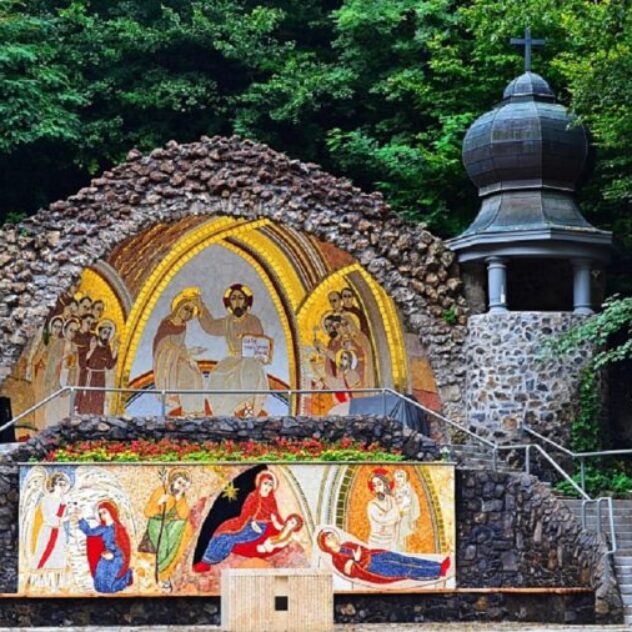Mátraverebély- Szentkút Nemzeti Emlékhely
Information about the pilgrimage site
Mátraverebély-Szentkút is located on the eastern side of the Cserhát region in Nógrád County. The history of the pilgrimage site dates back to the 1090s when, according to tradition, King Saint Ladislaus fled from his enemies but reached a cliff edge where he thought his life would end. However, his horse jumped, and at that moment, the spring of today’s Szentkút burst forth. The church of Mátraverebély became increasingly well-known and popular as a pilgrimage site from the 13th century onwards. With the help of a Transylvanian voivode, the former church was renovated, and at the end of the 1300s, a Gothic-style church was built, which had indulgences from around 1400.
The first recorded miracle dates back to the 17th century when a mute boy drank water from a horseshoe and suddenly regained his speech. The memory of the miracle has been preserved through various stories, as another tradition tells of the Virgin Mary appearing in the crown of an oak tree, instructing the boy to drink water found at the roots of the tree. In 1767, after bathing in the water of Szentkút, Reverend Mihály Szentmihályi miraculously relieved his terrible back pain. As a token of his gratitude, he wrote the first book about Szentkút. The number of miracles continued to increase, prompting Pope Clement XI to grant indulgence to the pilgrimage site.
The first chapel at Szentkút was built in the 1710s. Between 1758 and 1763, the current sanctuary was built, which was bestowed with the title “basilica minor” by Pope Paul VI in 1970. Alongside the sanctuary, a monastery was also built at the same time. It is believed that hermits inhabited the hillside above the sanctuary since the Middle Ages, but reliable sources are only available from the 17th century onwards. Initially, Cistercian monks served, and from 1772, Franciscans lived in the monastery. Due to the decrees of Emperor Joseph II, the site flourished again only in the 20th century, but in 1950, the dictatorship drove out the monks. Franciscans returned to Szentkút in 1989, where they renovated the exterior of the church and resumed their service. The pilgrimage site began to attract more and more pilgrims again. In 2006, Cardinal Péter Erdő declared Szentkút a National Shrine, as Hungary’s most significant pilgrimage site. The main pilgrimage of the sanctuary is held on the Sunday closest to the Feast of the Assumption of the Blessed Virgin Mary each year. After a renovation in 2015, an outdoor worship area awaits visitors, which can also be the venue for various events.
Tourist attractions in the vicinity
Hollókő – is located 34 km away from Szentkút. It is the first village in the world to be listed as a UNESCO World Heritage Site. It is known for its architectural style of the Old Village. There are 67 buildings and the church included in the protected structures. Hollókő has not been turned into an open-air museum, so people still live in the houses today. The locals preserve Palóc traditions. Hollókő’s most famous event is the Hollókő Easter Festival, where visitors can experience Palóc gastronomy, folk customs, and participate in folklore programs. An outstanding program on Easter Monday is the tradition of watering (locsolás). The village is home to the Village Museum, Post Office Museum, Doll Museum, and Heritage House.
Galyatető – Galya Lookout Tower since 1934, Hungary’s highest lookout tower, the 30-meter-high Galya Lookout Tower, has been welcoming hikers. The tower offers an unparalleled panorama to visitors, with views of the Bükk, Börzsöny, Cserhát, and even the Slovak mountain ranges. On clear days, the Mecsek, High Tatras, and the Piszkéstető Observatory can also be seen. The tower has won several domestic and international awards, including the Architizer Audience Award from the American online magazine. The lookout tower is located along the route of the National Blue Trail.
The Piszkéstető Observatory – is located at the heart of the Mátra Mountains, 944 meters above sea level. The observatory was built in the likeness of the constellation Leo. During visits, guided tours are available, where visitors can learn about the RCC telescope used for major interstellar research, a Schmidt telescope, and various other instruments. Research activities are ongoing at the observatory.
Mátraszentimre: Csörgő Gorge –- welcomes hikers in every season, but it offers a particularly enchanting sight in spring due to the fragrant lilacs that cover the area. Visitors can explore the beautiful natural environment among the several tens of meters high andesite walls. The gorge is accessible through numerous hiking trails, some of which are suitable even for families with young children.
Mátraszentimre: Mátra Mineral House – it was once the vacation home of a paleontologist professor. Visitors can see over a thousand minerals and mineral associations found in Hungary and abroad. Besides the exhibition hall, visitors can explore a lapidary workshop. They can observe minerals in a UV chamber, try gold panning, or even participate in mineral collector tours.
Other tourists attractions in the vicinity of the pilgrimage site can be found on their county website: https://www.nogradgeopark.eu/hu/nogradi-turisztikai-informacios-kozpont
Accommodation
– Pilgrim accommodation: pilgrims can stay either Pilgrim’s Lodge (https://szentkut.hu/szallashelyek/szallashelyek/zarandokhaz) or in a hostel (https://szentkut.hu/szallashelyek/szallashelyek/zarandokszallas)
– Other private accommodation near the pilgrimage site.
Availability
By car
The pilgrimage site can be reached via the 21st main road from Budapest. At the village of Mátraverebély, turn left, and from there it’s about 5 km to the Sanctuary.
Szentkút is only 19 km away from Salgótarján, and it can be reached via the 21st main road, where the Basilica of the Assumption of the Blessed Virgin Mary is accessible.
By public transport
It is recommended to visit the pilgrimage site with a special bus service. From Budapest, it takes about 2 hours by bus to reach Szentkút.
On foot
Pilgrimage routes to the Sanctuary are regularly organized. A 2-day pilgrimage from Szécsény to Mátraverebély-Szentkút is organized by the Franciscans.
On a bicycle
The Franciscans organize bicycle pilgrimages from Esztergom to Mátraverebély-Szentkút through Szécsény. A Franciscan Youth Pilgrimage is organized from Esztergom to Mátraverebély-Szentkút. The faithful walk about 20-25 km per day for 7 days.








